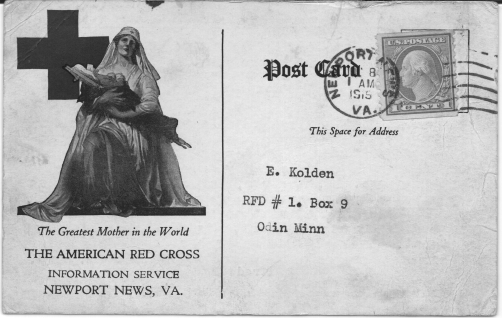


The 10th Battalion, 20th Engineers
Note: Most of the text of this article comes from "TWENTIETH ENGINEERS -- FRANCE - - 1917-1918-1919"
The Tenth Battalion
The Tenth and final Battalion of the Twentieth Engineers was formed in December, 1917, to function as a Depot unit for the earlier Battalions. For three months it served as a halfway station between the recruit barracks, Walter Reed Hospital, and the outfits destined for immediate embarkation. During this period its Personnel changed constantly, and it was not until the Ninth left for France, March 26th, 1918, that the Tenth was seriously organized as an overseas Forestry unit.
Six weeks of drill, equipping and waiting, in about equal parts, and the rearguard left Camp American University May 8th; sailing from Hoboken two days later aboard the "Pastors" which had already conveyed the Seventh Battalion across. On this voyage she joined a large convoy of 13 transports. The impetus given troop movements by the German drive in every phase of the trip. No subs were encountered, though the convoy came in for a thrill when an unwary whale poked his periscope over the surface, and became an immediate and total loss.
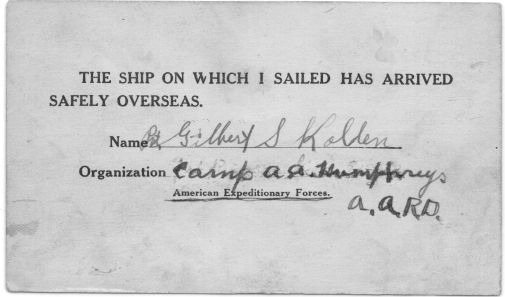
Red Cross postcards used by soldiers to notify their parents of safe arrival overseas, from Private Gilbert S. Kolden
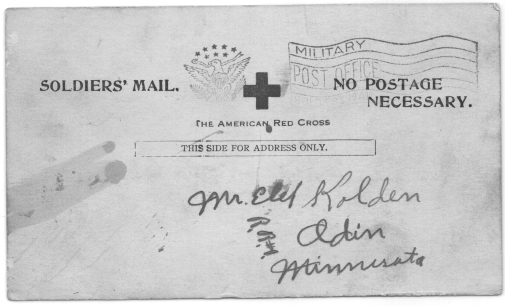
The convoy anchored in Brest harbor May 23rd, and the Tenth Battalion were lightered ashore the next day. The customary but entirely misnamed rest camp at Pontenezan sheltered them for a week, while plans were completed for their movement to permanent stations. As with most of the Forestry units the outfit was split up, Co. F being ordered to the Epinal district, under Second Battalion Headquarters, while the remainder of the Tenth were assigned a new district, with Bourges, in the center of France as headquarters.
Like the Third and Fourth, the Tenth Battalion went overseas with considerable extra strength. The attached men were designated as casuals, and were to be employed as replacements in earlier Battalions. While at Brest the extra men, 96 in all, were assembled and attached to Co. D, with whom they remained until July. Their further adventures were varied: from one outfit to another they drifted, always with that dazed atmosphere that clings to a confirmed casual. The entire group were transferred to the Sixth Battalion in July; the majority almost immediately sent out on detached service, nearly all the Forestry camps in the Landes region receiving a quota. About forty were finally transferred into the 11th and 12th Co.s, north of Mimizan, on the Coast, but retained their traditional luck by being held on detached duty with neighboring operations until after the Armistice. Of all the veterans of the Twentieth, the orphan 96 must surely be accorded the Fourragere de S. O. L. avec palme. Always going, coming, or there; and there meant the worst details, the slimmest chances for leave, the leakiest tents no chance for stripes, castles or wheels; no mail from home for months on end.
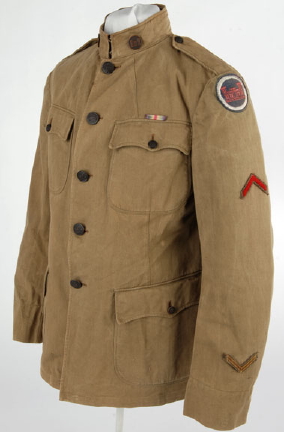
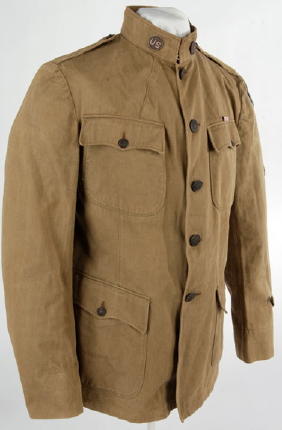
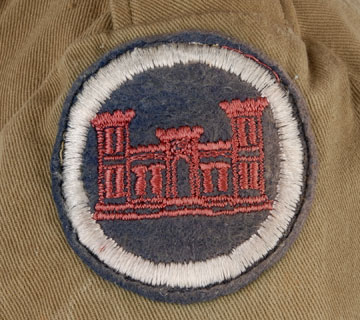
Uniform of Pvt. Gilbert S. Kolden, 31st Company, of Odin, Minnesota.
Notice the patch, of the Service of Supply with Engineer Castle.
May 29th, 1918, Tenth Battalion Headquarters and Co.s D and E left Brest for the Dept. of Cher. The headquarters detachment took up quarters in the ancient city of Bourges, with the companies deployed for duty in neighboring oak forests.
Co. D, soon to be renamed the 28th Co., arrived at their permanent station May 30th, 1918, at the village of La Celle Bruere, Cher. The first night was spent in a military manner— pup-tents in the foreground. Camp construction and logging occupied the first two weeks. June 14th the first carload of mill machinery arrived, and by dint of day and nightly exertion the first board from the 20M capacity American mill was sawn June 29th.
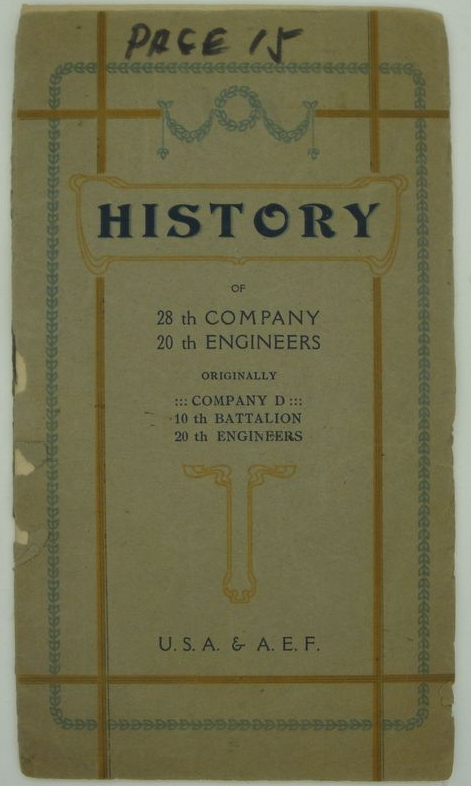
Locally Produced History of the 28th Company, Printed in France
Includes all soldiers' addresses and list of casualties
From the first the operation presented difficult problems. In July the unit was required to rebuild the ancient bridge spanning the Cher, the required timbers being brought over a thirteen mile haul. At all stages of logging activities, the French regulation requiring trees to be felled even with the ground worked trouble, the oak stand running unusually heavy to swelled butts.
As Fall set in, the injudicious location of the mill site and camp became apparent. The locality was low and undrained, and at one time camp and mill were flooded.
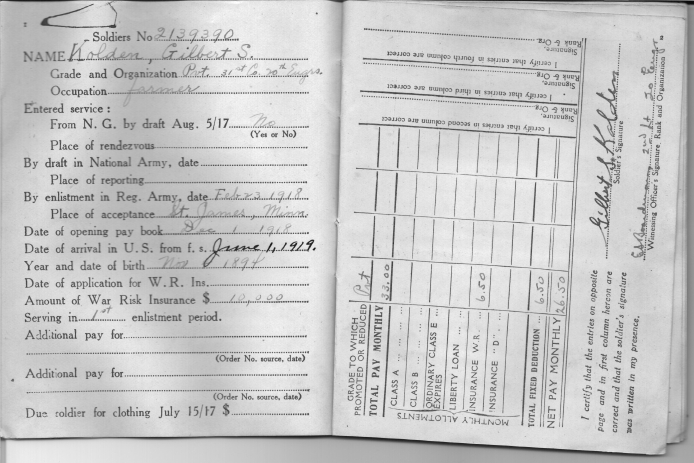
The paybook for Private Gilbert S Kolden, 31st Company.
Click the image for more of the paybook and other belongings of Private Kolden.
In August a detachment of 29 men were detailed to operate a French sawmill at La Ferte St. Aubin, Loiret, with a force of 220 civilians. The trials and temptations of this unit were legion. The only available interpreter in the outfit was the cook, and his leisure moments were in more frequent demand than supply.
The strength of the La Celle operation was increased, early in August, by the arrival of the 13th Service Co. After the demand for fuelwood in the northern camp necessitated further increase in the force, and Co.s B and C of the 347th Labor Battalion arrived December 21st.
Apart from cessation of timber felling, the Armistice made no change in the program for the 28th Co. It was not until March that working hours were reduced from ten to eight. The mill was shut down late in January. From that time until the first of May fuel production occupied all hands. The La Celle Bruere included the repair of about 40 miles of highway.
Memorial Day, 1919—exactly a year from the Company's arrival—the outfit entrained for Le Mans, where for ten days the formalities designed for fitting soldiers for ocean trips occupied the time. The next move was to Brest, whence the 28th and 29th Co.s embarked June 23rd aboard the battleship "New Jersey.'' The voyage, unmarked by speed or incident ended at Newport News the 4th of July. Two days later final inspection was held was held in the torrid Virginia sun, and the 28th and 29th Co.s 20th Engineers, stepped out of the Army lists into history.
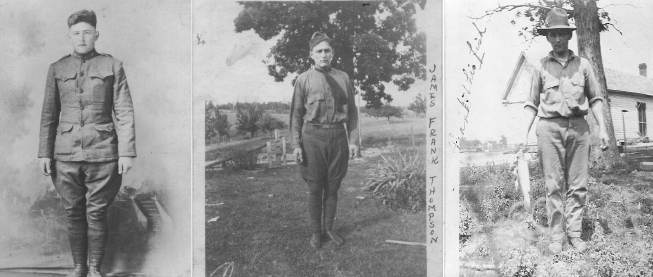
Private James Thompson of Company E, 10th Battalion (later 29th Company), 20th Engineers
Click the photo for more photos and information about Private Thompson, to include his SOS card
The 29th Co. had been assigned an operation at Chenonceaux, some twenty miles east of Tours. A separate woods camp established in the Foret de Amboise, several miles from the mill. Logging and sawing were carried on steadily till late in January after which fuel production continued until the ubiquitous work fell due. The outfit drew as its quota a radical group of highways east of Tours, and labored until the first of June, when departure was ordered. They left Chenonceaux June 3rd , and joined the 28th for the homeward trip.
Company F left Brest June 1st, 1918, under orders attaching them to Second Battalion Headquarters at Epinal, in the Vosges. A three day trip in third class cars brought them to their permanent station, the village of Cornimont, in Moselotte, about twelve miles south of Granges, where Co. D of the Second Battalion was operating.
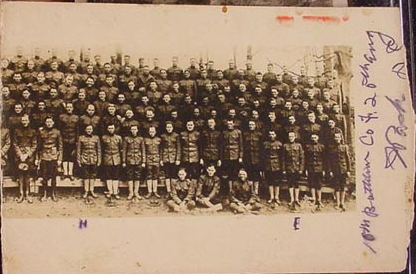
Company F, 10th Battalion, 20th Engineers
The first day in the new camp had its thrills. A bevy of enemy planes hove into view, and were greeted with a fusillade of A. A. fire from batteries surprisingly nearby.
While construction of F Co.'s new 20 M mill was under way at La Bresse, nine miles above Cornimont, half the outfit were detailed to Granges, where they assisted the 4th Co. until August 2nd. The mill of the 6th Co., as F was later designated, was completed June 29th. A night shift was commenced two weeks later.
Reminders of the proximity of the enemy lines—eight miles— were frequent. Almost daily visits of German planes, and constant clamor of artillery, were supplemented by the passing of combat troops to and from the lines. This sector was held by the French most of the time, though several American divisions the Sight-seeing 6th, the 35th, and 88th, were present for short periods.
Late in August the unit was reinforced by a company of the 517th Service Battalion. September 1st a small detachment was sent to operate with the First Army Forestry Force near Verdun, where they served until after the Armistice.
The mill operated until December 24th. Ten days later the mill and woods force returned to Cornimont, where the yard and shipping detail had been stationed. A week of cleanup details and the outfit bade farewell to the Vosges and entrained for their second hitch of Forestry in the Burnt Area of the Landes, whither their old Battalion Headquarters had already reported, accompanied by Co. G (31st Co.). From this time on the 6th Co. remained with their original organization, leaving the Burnt Area for the neighboring camp at Lake Aureilhan May 9th, and for Bordeaux the 13th.
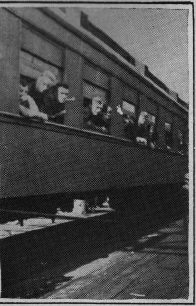
6th Company on their way home
Company G of the Tenth Battalion, the 31st Co. as finally known, was of unique origin and composition. As the records of the Chief of Engineers express it, the Sixth Battalion was authorized to be increased by one company, June 4th, 1918, and this company was transferred, upon organization, to the Tenth. As a matter of fact, the company was an outgrowth of the New England Forestry unit, a civilian group operating in Scotland, whose activities are narrated elsewhere in this volume. Upon completion of their tasks in Britain, the members of the unit were given the option of returning to the States or enlisting direct in the A. E. F. Of the number who elected to enlist, sufficient chose the Twentieth Engineers to form a Forestry Co.; four men were commissioned in the Regiment, and 87 were enlisted.
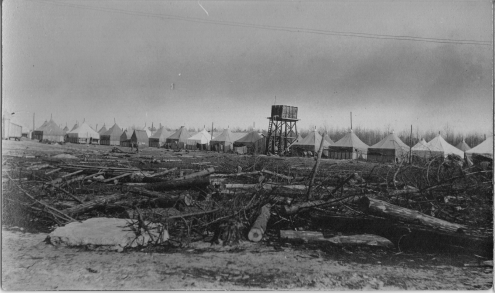
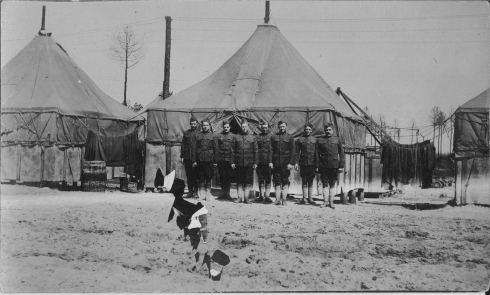
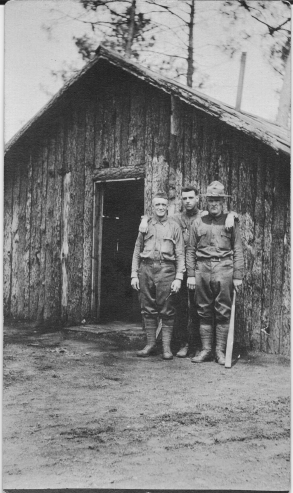
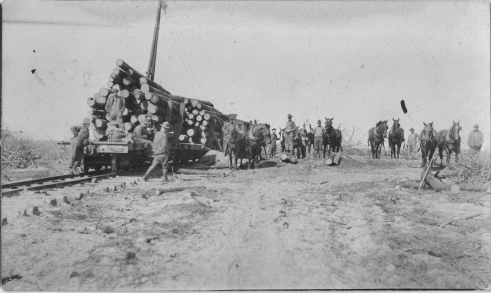
The new unit was sent to Winchester, in southern England, for training and equipment. Here they spent two months; started for France August 23rd, 1918, via Southampton and Cherbourg and reached the Bourges (Tenth Battalion) District August 27th. For three weeks the unit was attached for duty to the La Celle Bruere. As soon as equipment arrived, they were assigned a lumbering operation at Couleuvre, Dept. of Allier and there they served until after the Armistice.
The exploitation of the Pontenx Burnt Area, in the Landes was of particular moment to the Tenth Battalion. Headquarters, located up to this time at Bourges, and the 6th and 31st Companies, drew season tickets to the attraction. In fact, Tenth Battalion Headquarters was made the controlling organization of the combined Districts of Pontenx and Mimizan, with Major P. E. Hinkley in command of a force consisting at its maximum of seventeen companies.
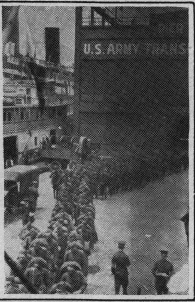
6th Company returns to the United States at Pier 8, Hoboken, New Jersey
The bulk of the Burnt Area
force, including Tenth Headquarters, the 6th and 31st Companies, left
the Landes May 13th for Bordeaux, and embarked May 17th aboard the
transport, USS K. I. Luckenbach.
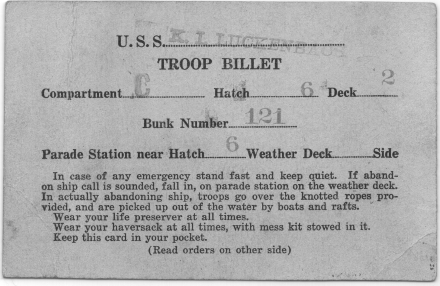
Troop billeting card of Pvt. Gilbert S. Kolden, 31st Company, aboard the USS Luckenbach
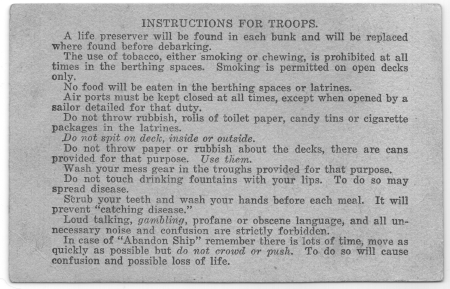
.jpg)
They landed at Pier
8, Hoboken, June 1st, 1919, ferried to a landing on the Hudson, and
hiked the intervening eight miles, fullpack, to Camp Merritt, whence
the last stages of muster out were put in action.
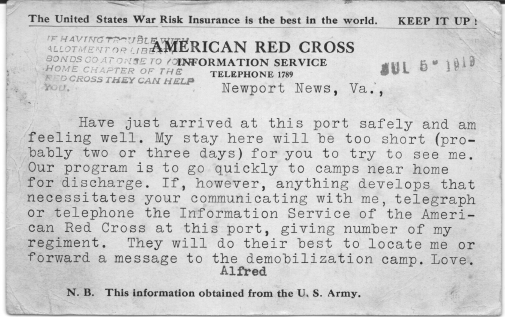
Common-use post card provided by the American Red Cross sent to parents notifying
them of son's safe return to U.S. port, from Pvt. Gilbert S. Kolden, 31st Company
